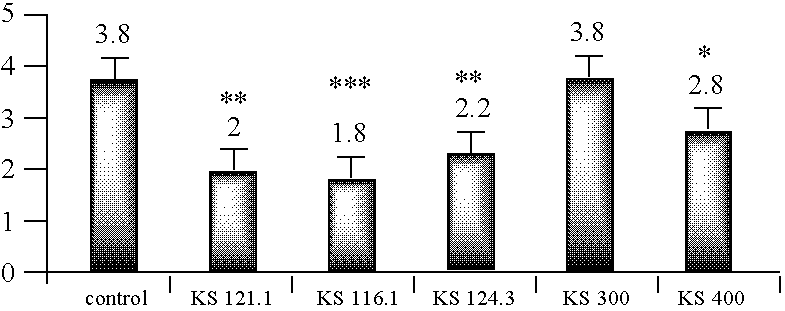Lactic acid bacteria strains useful against urogenital pathogens and compositions containing same
- Summary
- Abstract
- Description
- Claims
- Application Information
AI Technical Summary
Benefits of technology
Problems solved by technology
Method used
Image
Examples
example 1
1. Adhesion Capacity of L. Jensenii KS 119.1 and KS 130.1, L. Crispatus KS 116.1 and L. Gasseri KS 124.3 onto HeLa and Caco-2 / TC7 Cells.
[0079] The level of adhesion of the above strains was determined after the cells were inoculated with four concentrations of lactobacilli (5×107; 1×108; 5×108; 1×109 CPU / well). Generally, a concentration-dependent adhesion was observed.
[0080] In cervix HeLa cells, adhesion levels observed show that all the tested strains are adhering. The L. jensenii KS 119.1 and KS 130.1 strains appeared the best adhering strains (7.5 log CFU / ml at 5×108 CPU / well) as compared with the control adhering strains, L. casei rhamnosus GG and L. rhamnosus GR1 strains.
[0081] In intestinal Caco-2 / TC7 cells, adhesion levels observed show that all the Medinova strains are adhering. The L. crispatus KS 116,1, L. jensenii 119.1,129.1 and KS 130.1, L. gasseri 124.3 strains appeared the best adhering strains (7.5-8 logs CFU / ml at 5×108 CPU / well) as compared with the control a...
example 2
1. Activity of L. gasseri KS 124.3, L. helveticus KS 300 and L. acidophilus KS 400 on the Growth of Urogenital and Intestinal Pathogens.
[0100] It has been examined whether the strains referred to here above are active against the growth of Staphylococcus aureus, Streptococcus agalactiae, Candida albicans and uropathogenic and diarrheagenic E. coli strains IH11128 and 7372. The growth of pathogens was measured at 5, 8, 18 and 24 h.
[0101] No activity was developed against Streptococcus agalactiae and Candida albicans by L. gasseri KS 124.3, L. helveticus KS 300 and L. acidophilus KS 400 as well as by the control strains GR-1 and RC-14.
[0102] Concerning Staphylococcus aureus, the control L. rhamnosus strain GR-1 and L. fermentum strain RC-14 efficiently inhibited the growth of the bacteria. Similarly, L. gasseri KS 124.3, L. helveticus KS 300 and L. acidophilus KS 400 inhibited the growth of Staphylococcus aureus and showed a decrease in the viable bacteria number. When activities ...
example 3
1. Killing Activity of L. jensenii KS 121.1 and KS 122.1, L. gasseri KS 120.1 and L. helveticus KS 300 Against Urogenital and Intestinal Pathogens.
[0112] It has been examined whether said lactobacillus strains are active on the viability of Streptococcus agalactiae, Candida albicans, uropatho genie E. coli H11128, Gardnerella vaginalis, Prevotella bivia and Salmonella enterica Typhimurium. The effect on viability of pathogens was measured at 4 h of contact. Concerning both Streptococcus agalactiae and Candida albicans none of the tested lactobacilli showed an activity.
[0113] For uropathogenic E. coli strains IH11128, L. jensenii KS 121.1 and KS 122.1 showed no activity whereas, in contrast, L. gasseri KS 120.1 decreased efficiently (4 logs) the viability of E. coli in unshaken conditions. L. helveticus KS 300 and the L. fermentum RC-14 control strain decreased of 2 logs the viability of E. coli in unshaked conditions only.
[0114] Concerning Gardnerella vaginalis, both L. jensenii...
PUM
 Login to View More
Login to View More Abstract
Description
Claims
Application Information
 Login to View More
Login to View More - R&D
- Intellectual Property
- Life Sciences
- Materials
- Tech Scout
- Unparalleled Data Quality
- Higher Quality Content
- 60% Fewer Hallucinations
Browse by: Latest US Patents, China's latest patents, Technical Efficacy Thesaurus, Application Domain, Technology Topic, Popular Technical Reports.
© 2025 PatSnap. All rights reserved.Legal|Privacy policy|Modern Slavery Act Transparency Statement|Sitemap|About US| Contact US: help@patsnap.com


